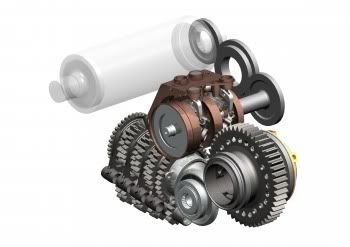“What has Formula 1 racing ever done for us?”
It is a valid question; I cannot think of any significant technological advance that to come from Formula 1 racing. Anyone who knows different is welcome to leave a comment by way of a correction.
There is always hope that one day Formula 1 will give the world of motoring something worthwhile; whether it is developing a new technology or embodying some desirable system. It may be that 2009 will be the year for good to be done, as Formula 1 cars incorporate a Torotrak transmission within the driveline.

What is a Torotrak drive? It is a vehicle transmission that does not rely on fixed gear ratios but offers a stepless spread of gear ratios between fixed upper and lower limits. It is not a new idea; the basic principles can be traced back to the 1930s, when it was known as the Perbury drive, but it needed materials and particularly lubricants that were not developed until the 1980s in order to work properly. To understand how the Torotrak works imagine an axle with two flat-faced discs mounted so that both are free to spin independently. Between the faces of the disks - parallel to the axle - is a roller, fixed in space but free to spin, with the circumference of the roller touching both disks. If you turn one disk the other disk will rotate in the opposite direction at the same speed. The principle is similar to the differential gear but relying on friction rather than meshing gears to transmit drive.
If the roller was not parallel to the axle but at an angle so that the roller described a larger circle on the face of one disk than the other then the two disks will turn at different speeds and there will be a torque multiplication or reduction depending on which disk is driven. Flat-faced disks are no good for a variable ratio transmission so the opposing faces of the disks are machined with circular tracks of curved cross section. The curved tracks mean that the roller (usually the real Torotrak has 2 or 3 to reduce wear) remains in contact with the opposing faces as it is tilted. To reduce stress on the friction components the output disk has the curved tracks on both faces and is sandwiched between two sets of rollers and facing input disks. The Torotrak transmission also incorporates an epicyclic gear set and a couple of clutches (which can be engaged or disengaged but never slip). One of the input disks drives the planet carrier, the output disk drives the sunwheel and the annulus drives the car.
It would be too much to hope that the Torotrak was going to replace the conventional transmission of a Formula 1 racing car. There is no reason why it wouldn’t work; back in 1994 or 5 Williams tried a Van Doorne CVT drive in their then current F1 car and David Coulthard lapped Silverstone two seconds faster than he managed in an identical car with conventional transmission. Two seconds, thanks to the oft derided “rubber band” transmission was a considerable and worthwhile advantage. Before Williams could incorporate the transmission in a racing car the rules were changed and such transmissions were banned. The Torotrak would offer similar advantages and probably enjoys similar prohibition.
So how is the Torotrak to be incorporated? In some sort of effort to appeal to or appease the environmental movement Formula 1 want to be seen as more ecologically aware and incorporate energy saving devices into F1 cars. One idea is a kinetic energy recovery system (KERS) which is another old idea brought up to date. Rather than “wasting” energy converting kinetic energy to heat when braking, kinetic energy is used to spin up a flywheel which can be disconnected from the drive line and reconnected when the stored energy can be put to good use driving the car. It is an old idea because the Swiss used it in busses working in hilly areas; energy “gained” running down one hill could be stored and used to assist the climb up the next hill. By using a Torotrak drive rather than a simple clutch the energy sent to or recovered from the flywheel can be controlled with greater subtlety.
Torotrak PLC (the name of the British company owning the rights to the Torotrak drive) have granted a license to Xtrax, the transmission specialists, to incorporate the Torotrak drive in a gearbox with a KERS. The idea is to provide a more compact, lighter, more efficient means of energy storage than electrical batteries. The hope is that not only will racing teams adopt the technology but that it will find its way into road cars too.
My hope is that the publicity given to the Torotrak transmission as a result of the F1 association will act as a catalyst for someone to put a Torotrak transmission in a car that people can buy. Just imagine an automatic transmission that overcomes all the limitations of conventional automatics. With luxury cars adopting seven and eight speed automatics a transmission that can be in the right gear all the time by eschewing the established conventions of fixed ratios has to be a good idea.

2 comments:
The only two things I can think of that have made it from F1 into road cars, and neither of which are welcome, are: 1) carbon fibre - usually in the form of pointless dashboard trim 2) paddles for changing gear.
How about computer controlled management systems, advanced braking systems, advanced suspension controls and anti skid technology. Coming up could be transponders to catch speedsters, red light jumpers, car theives and so on, all courtesy of F1.
Post a Comment